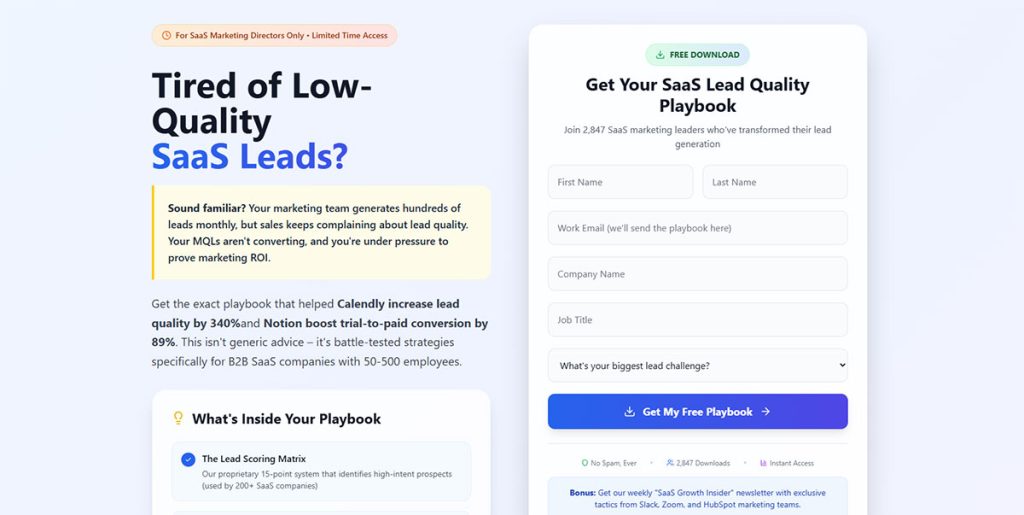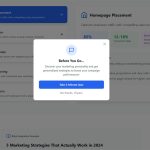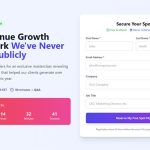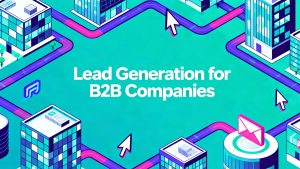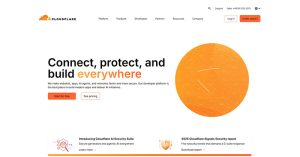Your sales team can’t close deals without qualified prospects in the pipeline. That’s the reality every B2B company faces. Lead generation for B2B companies determines whether your business grows predictably…
Table of Contents
Your prospects are drowning in free content, yet struggling to find solutions that actually work. Learning how to use gated content for lead capture transforms casual visitors into qualified prospects while building trust through valuable exchanges.
Smart businesses know that premium content offers generate higher-quality leads than basic opt-ins. When prospects willingly share contact information, they demonstrate genuine interest in your solutions.
This guide reveals proven strategies for creating, promoting, and optimizing gated resources that capture leads and drive revenue. You’ll discover how to identify content worth gating, design high-converting landing page forms, and nurture downloads into customers.
From lead generation strategy fundamentals to advanced marketing automation tactics, these actionable insights help businesses of any size build predictable lead capture systems that scale.
Strategic Planning for Gated Content Success
85% of B2B businesses see lead generation as their most important marketing goal. Success starts with knowing your audience inside and out.
Identifying Your Target Audience
71% of companies that exceed lead generation goals have documented buyer personas versus just 37% of average performers.
Start with data analysis:
- Review existing customer data in your CRM
- Analyze purchase patterns and engagement metrics
- Interview current customers about their challenges
- Survey email lists by segment
Map different audience segments and their unique pain points. A startup marketing manager faces different challenges than an enterprise CMO. Your gated content should speak to these specific needs.
The impact is significant:
- 82% of companies using buyer personas improved their value proposition
- 6x increase in customer engagement when targeting cold leads with persona-based content
- 36% of companies created shorter sales cycles using buyer personas
Setting Clear Goals and Metrics
Focus on quality over quantity. 61% of B2B marketers say quality leads are their biggest challenge.
Key benchmarks to track:
- Email marketing: 2.8% conversion rate (B2C), 2.4% (B2B)
- Landing pages: 8.8% to 18.2% conversion rates by industry
- Lead-to-customer: Only 20% of leads convert to sales
35% of businesses use automation tools mainly for lead generation. Those who adopt automation see 77% higher lead conversion than those who don’t.
Use marketing automation platforms to track the complete customer journey from download to purchase.
Content Value Assessment
91% of B2B marketers say content marketing generates more leads than traditional channels. The numbers prove it:
- 3x more leads than outbound marketing
- 62% less expensive than traditional methods
- 67% more leads for companies with active blogs
Volume drives results:
- Companies publishing 15 blog posts monthly generate 1,200 new leads
- Small businesses with blogs see 126% more lead growth
Video content is essential:
- 87% of marketers report video campaigns generate leads
- 66% of qualified leads come from video content annually
- 77% of marketers say podcasts are the top medium for lead conversion
Form optimization matters:
- Ideal forms have 3-5 fields for maximum conversion
- Microforms with 2-3 fields improve user experience
- Multi-step forms can increase conversions by 300%
Bottom Line
53% of marketers spend over half their budget on lead generation. The global lead generation market is projected to reach $15.5 billion by 2031 with 17.48% annual growth.
Success requires three things:
- Deep audience understanding through documented buyer personas
- Quality-focused goals with proper automation and tracking
- Genuinely valuable content that prospects can’t find elsewhere
Companies getting this right aren’t just generating more leads. They’re building sustainable competitive advantages through better customer relationships and shorter sales cycles.
Creating High-Converting Gated Content
Quality content drives everything else. 73% of B2B marketers say content marketing is the most effective strategy for boosting leads and sales.
Content Planning and Research
Target real problems. Look for questions your sales team answers repeatedly. These make excellent gated content topics.
Focus on keywords that convert. “Marketing automation best practices” works better than generic terms like “marketing.”
53% of all website traffic comes from organic searches — proper keyword targeting is essential.
Find competitor gaps. What topics do leading companies avoid? Where can you provide fresh insights?
Content Creation Best Practices
Write for your specific audience. Use their language. Address their challenges. Avoid jargon unless expected.
Structure for scanning:
- Clear headlines
- Bullet points
- White space
- Visual content is 43% more persuasive than text alone
Include actionable takeaways. Readers should finish with specific steps they can implement immediately.
Length matters. The average blog post is now 1,400 words — 77% longer than ten years ago. Audiences want depth.
Content Formats That Drive Results
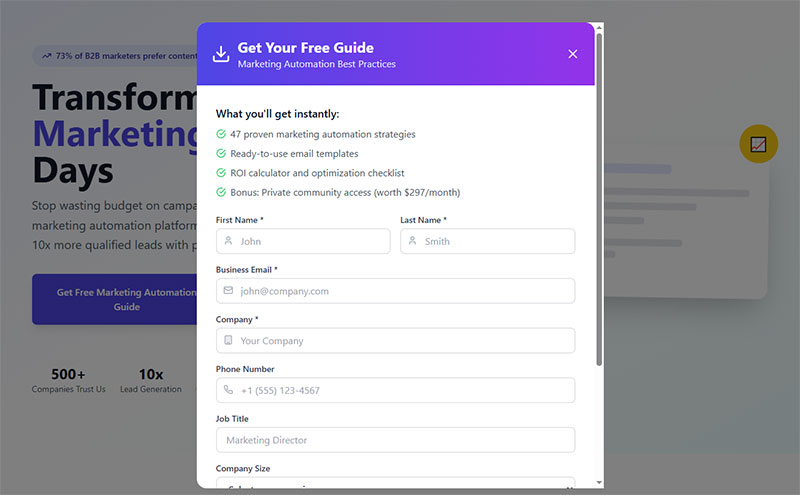
Long-form guides and ebooks establish thought leadership. Marketers rate gated content and long-form guides as the most effective blogging content.
Interactive content like quizzes and assessments. 50% more engagement than static content.
Video content delivers results:
- 91% of businesses use video as a marketing tool
- 21% of marketers say short-form video delivers the best ROI
- 87% report video campaigns help generate leads
Resource libraries provide ongoing value. Collections of templates and tools create lasting relationships.
Test systematically. Track which formats generate the highest quality leads for your business.
Lead Generation Performance
Content marketing wins:
- Generates 3x more leads than outbound marketing
- Costs 62% less than traditional advertising
- Companies with 16+ monthly blog posts get 3.5x more leads
Key statistics:
- 87% of B2B marketers successfully use content marketing to generate leads
- 74% say content marketing proves effective for lead generation
- 90% use content marketing as part of lead generation strategy
AI Integration
90% of content marketers plan to use AI in 2025 strategies.
Marketers using AI see 70% increase in ROI.
Use AI for:
- Outlining (71.7% of marketers)
- Brainstorming (68% of marketers)
- Research and ideation
68% of businesses see increased content marketing ROI thanks to AI.
Budget and Investment
Budgets are growing:
- 88.2% of businesses expect budgets to grow or stay the same in 2025
- 11.4% plan to spend over $45,000 monthly, up from 4.1% in 2024
- 54% spending over $2,000 per content piece report success
Measuring Success
Track what matters:
- 41% of marketers measure effectiveness through sales
- 62.8% see traffic growth year-over-year
- Only 20% of leads convert to sales — focus on quality
Content marketing revenue expected to reach $107 billion by 2026.
Remember: Great content provides value for months or years. Focus on evergreen topics. Test different formats. Content upgrades on existing posts often outperform standalone pieces.
Bottom line: Invest in quality gated content. The data proves it works.
Building Effective Landing Pages and Forms
Your landing page makes or breaks conversion rates.
Landing Page Design Principles

Clear headlines grab attention immediately. Your value proposition should be obvious within three seconds. Visitors shouldn’t guess what they’ll receive or why they need it.
Compelling content previews show exactly what’s inside your gated resource. Include table of contents, sample pages, or key takeaways. Screenshots work better than generic descriptions.
Social proof and testimonials build trust fast. Display logos of recognizable companies using your content. Include specific quotes about results achieved.
Mobile-responsive design isn’t optional anymore. Over 60% of web traffic comes from mobile devices. Test your landing page forms on different screen sizes before launching.
Remove navigation menus and other distractions. Your landing page should have one goal. Every element should support that conversion objective.
Lead Capture Form Optimization
Asking for the right information balances lead qualification with conversion rates. Name and email work for top-of-funnel content. Sales-ready offers might require company size and budget information.
Form length directly impacts conversion rates. Each additional field reduces completions by roughly 7%. Only request information you’ll actually use.
Progressive profiling strategies through marketing automation platforms like Pardot or ActiveCampaign gather more data over time. First download requires minimal info. Subsequent forms ask for additional details.
Clear privacy policies address growing data concerns. Link to your privacy policy and explain how you’ll use their information. GDPR compliance requires explicit consent for data processing.
Form validation prevents user frustration and improves data quality. Real-time error messages help users fix problems immediately.
Call-to-Action Best Practices
Button design affects click-through rates significantly. Contrasting colors that stand out from your page design perform best. Orange and red buttons often outperform blue or green.
Action-oriented language tells users exactly what happens next. “Download Your Guide” works better than “Submit.” “Get Instant Access” creates urgency without pressure.
Creating urgency through limited-time offers or exclusive access motivates action. Avoid fake countdown timers that reset. Authentic scarcity converts better.
A/B testing different approaches reveals what works for your specific audience. Test headlines, button colors, form fields, and page layouts systematically.
Test one element at a time for clear results. Testing multiple changes simultaneously makes it impossible to identify what drove improvements.
Promotion and Distribution Strategies
Great content needs smart promotion to reach your target audience.
Content Marketing Channels
Blog posts drive organic traffic to your gated content over time.
- 94% of B2B marketers create blog posts as their primary content format
- Companies with blogs produce 67% more leads monthly than those without
- Marketers who prioritize blogging see 13x more ROI
Write detailed articles that naturally lead to your premium resources. Include content previews and clear calls-to-action.
SEO helps prospects find your content when researching solutions. Target keywords your audience searches for. Long-tail phrases convert better than broad terms.
Social media teasers generate interest without giving everything away. Share key insights while positioning the full resource as essential reading.
Email marketing produces the highest conversion rates.
- $36 return for every $1 spent on average
- $45 return for retail and ecommerce businesses
- 52% of consumers made purchases directly from promotional emails
Segment your list based on interests and previous downloads.
Guest posting expands your reach to new audiences. Write for publications your prospects read.
Paid Advertising Approaches
Google Ads target people actively searching for solutions. Create campaigns around content-related keywords.
LinkedIn advertising excels for B2B:
- 40% of B2B marketers rate it as most effective for high-quality leads
- 80% of all B2B leads come from LinkedIn
- 2x higher conversion rates compared to other platforms
- 4x more leads with LinkedIn Lead Gen Forms
Facebook and Instagram work better for B2C audiences.
Retargeting website visitors shows ads to people who already know your brand. Higher intent audience means better conversion rates.
Track cost per lead across different channels. Focus budget on tactics that generate positive ROI.
Organic Reach Tactics
SEO drives consistent long-term traffic.
- 434% more indexed pages for websites with active blogs
- 76% of content marketers rely on blogs for lead generation
Create content clusters around your gated resources.
Social media requires consistent posting and engagement.
Top content formats in 2024:
- Short-form video (29.18%)
- Images (28.95%)
- Interviews (21.64%)
- Blog posts (19.47%)
Build relationships before promoting heavily.
Community participation establishes expertise. Answer questions on Reddit, Quora, and industry forums. Mention resources when genuinely helpful.
Email signatures create passive promotion. Include links to latest content in every business email.
Content repurposing maximizes investment. Turn ebooks into blog series, webinars into podcasts, guides into social posts.
Performance Tracking
Top ROI channels by business type:
B2B brands:
- Website, blog, and SEO efforts
- Paid social media content
- Social media shopping tools
B2C brands:
- Email marketing
- Paid social media content
- Content marketing
Key metrics to monitor:
- Conversion rates from content to leads
- Cost per acquisition by channel
- Time from content consumption to purchase
- Lead quality scores
- Return on advertising spend (ROAS)
Combine multiple channels for best results. Create unified messaging while adapting format to each platform’s characteristics.
Lead Nurturing and Follow-Up Systems
Converting downloads into customers requires systematic follow-up.
Immediate Response Strategies
Automated thank you emails set expectations immediately. Send confirmation within minutes of download. Include direct links to the promised content and clear next steps.
Content delivery methods vary by resource type. Email attachments work for smaller files. Larger resources need secure download links or member-only access areas.
Setting expectations prevents unsubscribes and complaints. Tell new leads how often you’ll email and what type of content they’ll receive. Transparency builds trust from the start.
Welcome messages should reinforce the value exchange. Remind subscribers why they downloaded your content and what problems it solves.
Email Sequence Development
Welcome series for new leads introduces your brand gradually. Send 3-5 emails over two weeks covering your expertise, customer success stories, and additional resources.
Educational content progression moves prospects through your sales funnel naturally. Start with awareness-stage content. Progress to consideration and decision-making topics.
Soft sales integration weaves promotional messages into valuable content. Share case studies, product demos, and customer testimonials without being pushy.
Segmentation based on interests personalizes the experience. Track which content pieces leads download. Send follow-up emails related to those specific topics.
Marketing automation platforms like ConvertKit and Mailchimp enable sophisticated nurturing campaigns. Set up behavioral triggers based on email opens, link clicks, and website visits.
Lead Scoring and Qualification
Identifying sales-ready leads requires clear criteria. Score prospects based on demographics, company fit, and engagement behavior. Higher scores indicate stronger purchase intent.
Behavioral tracking reveals true interest levels. Monitor email engagement, website visits, and content downloads. Multiple touchpoints suggest serious consideration.
Handoff processes to sales teams need clear documentation. Define when marketing qualified leads become sales qualified leads. Set up alerts in your CRM system for hot prospects.
Salesforce and HubSpot integration connects marketing activities to sales outcomes. Track the complete journey from first download to closed deal.
Lead scoring models should evolve based on actual conversion data. Review which activities predict successful sales outcomes.
Measuring Success and Optimization
Data drives better decisions and higher conversion rates.
Key Performance Indicators
Conversion rates at each stage reveal bottlenecks in your funnel. Track landing page visitors to downloads, downloads to email subscribers, and subscribers to customers.
Lead quality metrics matter more than volume. Measure how many leads become opportunities and customers. Track average deal size from different content sources.
Cost per lead calculations justify marketing spend. Include content creation costs, promotion expenses, and platform fees. Compare acquisition costs across different channels.
Revenue attribution tracking connects content performance to actual sales. Use first-touch, last-touch, and multi-touch models to understand content impact.
Customer lifetime value helps evaluate long-term content ROI. Leads from premium content often convert to higher-value customers.
Analytics and Tracking Setup
Google Analytics configuration tracks content performance across your website. Set up goals for downloads, email signups, and subsequent conversions.
Marketing automation tracking provides detailed engagement data. Monitor email open rates, click-through rates, and unsubscribe patterns by content type.
CRM reporting and dashboards show sales team perspectives on lead quality. Track which content sources generate the most qualified opportunities.
A/B testing frameworks enable systematic optimization. Test headlines, form design, email subject lines, and call-to-action buttons regularly.
Tag management systems organize tracking across multiple platforms. Use consistent naming conventions for campaigns and content pieces.
Continuous Improvement Process
Regular performance reviews identify trends and opportunities. Schedule monthly analysis of key metrics and quarterly strategy updates.
Content refresh and updates maintain relevance over time. Review statistics annually. Update outdated information and improve underperforming sections.
Form and landing page optimization never stops. Small improvements compound over time. Test mobile forms separately from desktop versions.
Audience feedback integration improves future content. Survey downloaded leads about content quality and topic preferences. Ask what additional resources they need.
Conversion rate optimization focuses on high-impact changes first. Prioritize tests based on potential traffic volume and expected improvement magnitude.
Competitive analysis reveals new opportunities and threats. Monitor what gated content competitors launch. Identify gaps in their offerings.
Performance benchmarking compares your results against industry standards. Join peer groups or purchase industry reports for context on your metrics.
Document successful tests and failed experiments. Build institutional knowledge about what works for your specific audience and industry.
Integration with Overall Marketing Strategy
Gated content works best when connected to your broader marketing efforts.
Aligning with Sales Processes
Lead qualification criteria must align between teams. Sales needs specific information to prioritize follow-up. Marketing should capture this data through progressive profiling.
Sales and marketing alignment prevents leads from falling through cracks. Weekly meetings review lead quality and feedback. CRM integration tracks which content sources generate closed deals.
Content requests from sales teams reveal real prospect needs. Field teams know which objections come up repeatedly. Create gated resources addressing these specific concerns.
Closed-loop reporting connects marketing activities to revenue outcomes. Track the complete customer journey through your CRM system. Measure ROI of individual content pieces.
Content Marketing Ecosystem
Connecting gated and ungated content creates natural progression paths. Blog posts introduce topics. Gated resources provide deeper analysis. Webinars offer personal interaction.
Cross-promotion opportunities maximize content value. Reference premium resources in blog posts. Include ungated previews in email campaigns. Share insights across multiple channels.
Content repurposing strategies extend asset lifespan. Transform ebooks into multi-step forms with chapter-by-chapter delivery. Create video summaries of written guides.
Building content libraries establishes ongoing value. Organize resources by topic, industry, and buyer journey stage. Make previous downloads easily accessible to subscribers.
Customer Journey Mapping
Placement in the buyer’s journey determines content topics and depth. Awareness stage needs educational content. Consideration stage requires comparison guides. Decision stage benefits from case studies and demos.
Supporting decision-making processes requires understanding prospect evaluation criteria. What questions do buyers ask? Which factors influence final decisions?
Moving leads through the funnel happens through strategic content sequencing. Early downloads should naturally lead to more advanced resources. Email nurturing guides this progression.
Post-purchase content strategies retain customers and generate referrals. Onboarding guides reduce churn. Advanced tutorials increase product adoption.
Legal and Ethical Considerations
Responsible data handling protects your business and builds trust.
Data Privacy Compliance
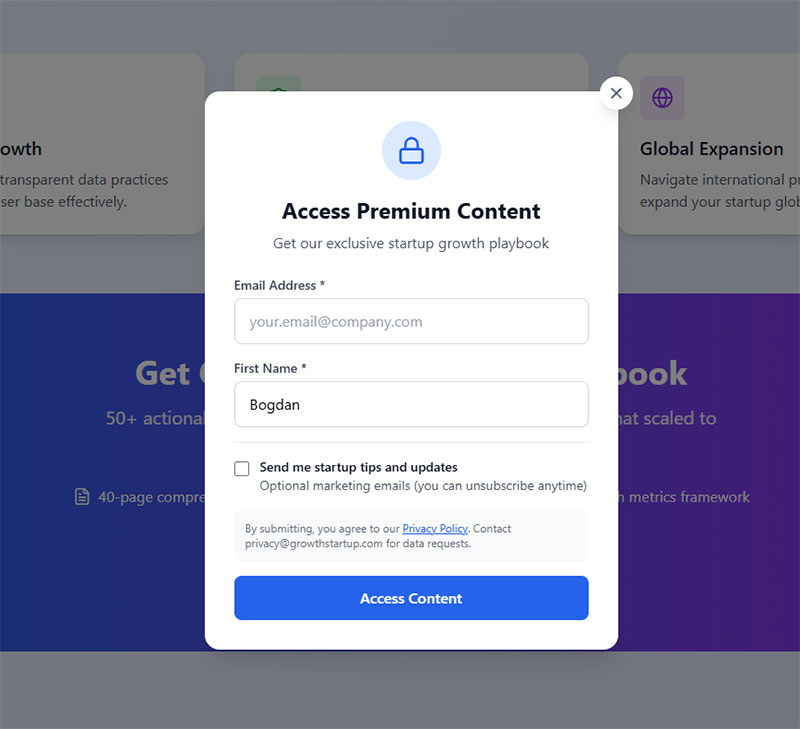
GDPR and CCPA requirements govern how you collect and use personal information. Document your legal basis for processing. Implement data retention policies. Provide easy opt-out mechanisms.
Clear consent mechanisms prevent compliance issues. Use GDPR compliant forms with explicit checkboxes. Explain data usage in plain language. Avoid pre-checked boxes.
Data storage and security practices protect sensitive information. Use encrypted databases. Limit employee access to necessary data only. Regular security audits identify vulnerabilities.
Right to deletion and access requests require systematic processes. Maintain contact databases that allow easy record removal. Provide data export options for user requests.
Transparency and Trust Building
Clear value exchanges set appropriate expectations. Tell prospects exactly what they’ll receive and how you’ll use their information. Hidden agendas damage long-term relationships.
Honest marketing practices build sustainable businesses. Avoid misleading headlines or false urgency tactics. Deliver promised value consistently.
Respecting subscriber preferences reduces unsubscribes and complaints. Honor frequency preferences. Segment content by interests. Provide granular subscription controls.
Building long-term relationships matters more than short-term conversions. Focus on genuine value creation. Treat subscriber data as a privilege, not a right.
Content Rights and Usage
Original content creation avoids copyright issues. Develop proprietary frameworks and methodologies. Cite external sources properly when referencing industry data.
Proper attribution and licensing protect intellectual property rights. Use licensed stock photos and graphics. Credit all external sources in your content.
User-generated content policies clarify ownership and usage rights. Obtain explicit permission before featuring customer content. Provide clear guidelines for submissions.
Trademark and copyright considerations apply to all content elements. Research existing trademarks before naming resources. Avoid using protected terminology without permission.
Regular legal reviews ensure ongoing compliance. Laws change frequently. Update privacy policies annually. Consult legal counsel for complex situations.
International regulations vary significantly. Research requirements for each target market. Different regions have different consent standards and data protection rules.
Advanced Tactics and Scaling
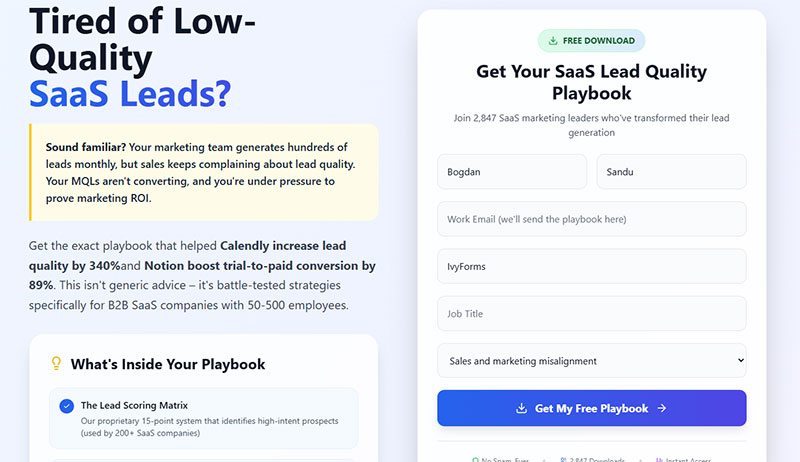
95% of senior marketers consider their personalization strategies successful, yet most struggle with execution.
Personalization Strategies
Dynamic content based on user data transforms generic resources into tailored experiences. Companies with personalized experiences generate 40% more revenue.
Use marketing automation platforms like Marketo or Pardot to customize content sections based on industry, company size, or previous downloads.
Create modular content that adapts automatically. Software companies need different metrics than manufacturing firms.
Behavioral trigger customization responds to user actions. 72% of consumers only engage with personalized marketing messages. Track engagement patterns across your content library.
Key personalization impact:
- 76% of consumers prefer brands that personalize experiences
- 71% expect personalized interactions
- 95% of customer interactions will be AI-driven by 2025
Conditional logic in forms creates personalized experiences. Show relevant questions based on previous answers.
Multi-Channel Integration
Cross-platform consistency maintains brand trust. Your gated content experience should feel identical across email, social media, and paid ads.
Strong omnichannel engagement retains 89% of customers compared to 33% for weak strategies.
Multi-channel results:
- 287% sales increase from omnichannel marketing
- 250% higher purchase frequency vs single channel
- 30% higher lifetime value for omnichannel shoppers
- 5x higher order rates for multi-channel campaigns
Connect your CRM, email platform, and analytics tools. Zapier automates data flow between systems.
Track which channels contribute to conversions. Multi-touch attribution reveals the true customer journey.
Scaling Content Production
Content creation workflows standardize quality and speed. Document templates, approval processes, and publishing schedules.
76% of content marketers use AI to draft content, while 83% report increased productivity.
AI efficiency gains:
- 5+ hours saved weekly per marketer
- 79% see streamlined processes
- 36% spend less than one hour on long-form posts
Create content checklists covering accuracy, formatting, and brand compliance. Review cycles catch errors before publication.
Content calendar management coordinates multiple projects. Plan quarterly themes and monthly topics around product launches and industry events.
Template libraries accelerate creation. Develop reusable formats for different content types.
Performance tracking systems identify winning formulas. Monitor which content formats generate the highest quality leads.
Marketing automation ROI:
- $5.44 return for every $1 spent
- 76% see ROI within first year
- 83% automate social media processes
- 75% automate email marketing tasks
Use AI for research and initial drafts. Focus human creativity on strategy and refinement.
Collaboration platforms connect distributed teams. Use project management tools for task tracking.
Train team members on lead generation strategies and content best practices.
80% of organizations will adopt intelligent automation by 2025, making workflow optimization critical for competitive advantage.
FAQ on How To Use Gated Content For Lead Capture
What type of content should I gate?
Gate premium resources that solve specific problems. Comprehensive guides, industry reports, exclusive templates, and detailed case studies work best. Avoid gating basic information that prospects can find elsewhere. Focus on content value assessment and proprietary insights.
How many form fields should I include?
Use 3-5 fields maximum for top-funnel content. Name, email, and company typically suffice. Progressive profiling through marketing automation platforms like HubSpot collects additional data over time. Each extra field reduces conversion rates by approximately 7%.
What’s the ideal conversion rate for gated content?
Expect 15-25% conversion rates for valuable resources. Industry averages vary significantly by sector and audience. B2B content typically converts higher than B2C. Conversion rate benchmarks depend on traffic source and content quality.
Should I gate all my best content?
No. Balance gated and ungated content strategically. Use blog posts to demonstrate expertise and drive traffic. Gate deeper resources that require significant time investment. Content marketing funnel needs both awareness and conversion assets.
How do I promote gated content effectively?
Combine organic reach tactics with paid promotion. Create supporting blog posts, social media teasers, and email campaigns. Google Ads and LinkedIn advertising work well for B2B audiences. Track cost per lead across channels.
What landing page elements drive conversions?
Clear headlines, compelling previews, social proof, and mobile-responsive design. Remove navigation distractions. Include testimonials and company logos. Landing page design should focus solely on conversion goals without competing elements.
How quickly should I follow up with new leads?
Send automated confirmation emails immediately. Begin nurturing sequences within 24 hours. Lead nurturing campaigns maintain engagement while qualifying prospects. Speed of response significantly impacts conversion rates to customers.
Which tools work best for gated content?
WordPress with lead generation plugins, HubSpot for automation, and Unbounce for landing pages. ConvertKit handles email sequences effectively. Choose platforms that integrate with your existing CRM system and marketing automation stack.
How do I measure gated content success?
Track conversion rates, lead quality scores, and revenue attribution. Monitor cost per lead and customer lifetime value. Use Google Analytics goals and CRM reporting. Focus on leads that become actual customers, not just download volume.
What legal requirements apply to gated content?
Ensure GDPR compliance with clear consent mechanisms. Include privacy policy links and data usage explanations. Implement proper data storage security. Different regions have varying requirements for user consent management and data protection.
Conclusion
Mastering how to use gated content for lead capture requires strategic planning, quality creation, and systematic optimization. Success depends on understanding your audience’s specific needs and delivering genuine value through every exchange.
Subscriber acquisition works best when you focus on quality over quantity. High-converting resources generate better prospects than generic offerings. Your email list building efforts should prioritize engaged leads who match your ideal customer profile.
Effective prospect engagement happens through:
- Conversion optimization of forms and landing pages
- Audience segmentation based on interests and behavior
- Lead scoring systems that identify sales-ready prospects
- Customer journey mapping that guides content strategy
Digital marketing metrics reveal what’s working and what needs improvement. Track revenue attribution, not just download numbers. Marketing qualified leads matter more than volume.
Remember that content personalization and drip email sequences nurture relationships over time. Your gated content strategy should integrate seamlessly with broader sales funnel optimization efforts for maximum impact.
